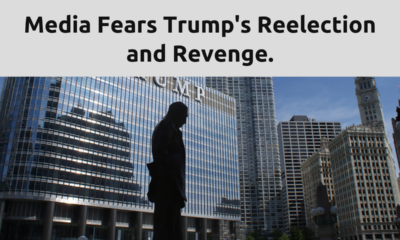Executive
Electric vehicles fail without heavy subsidies
Electric vehicles haven’t lived up to the hype and would never sell without heavy subsidies. Voters should not support such a project.
Are electric vehicles worth the hype? Or do they merely shift a (legitimately measurable) pollution burden and represent another do-good mirage of public policy? Do they solve a real environmental problem – and if so, do they create others? In sum, does a concerted program to electrify the developed world’s vehicle fleet have a moral justification? For the first time, people are starting to crunch the numbers, and the numbers are telling a sobering story. Tax- and ratepayers need to know what they’re paying, what they are paying for, and whether it’s worth it.
Electric vehicles do not provide a free benefit
On October 28, 2023, The Western Journal revealed an economic study damning to battery-powered electric vehicles. The problem is: at current demand, they cost far more to make and own than most people see. That includes their owners and everyone who is even thinking of buying one.
The Texas Public Policy Foundation makes their study available here.
Their study charges that electric vehicles (EVs) benefit from $22 billion in direct and indirect subsidies to EV makers. Without them, says the Foundation, the total cost of ownership of an EV would be equivalent to owning a conventional vehicle and paying $17.33 per gallon to fuel it for the same distance driven.
The TPPF study counts as direct subsidies such things as:
- Tax credits from federal and State taxing authorities, available to EV buyers up-front,
- Direct tax subsidies for charging infrastructure, and
- Marginal electricity generating, transmission and distribution costs. Electric utility ratepayers pay these costs – whether they own an EV or not.
Then they measure indirect subsidies in the form of regulatory credits. In point of fact, the National Highway Traffic Safety Administration and the Environmental Protection Agency invented cap-and-trade systems long before the phrase became popular. NHTSA calls their system the Corporate Average Fuel Economy Standard (CAFE). EPA calls theirs the Greenhouse Gas (GHG) Multiplier Credit system.
Cap-and-trade systems – a history
Any cap-and-trade system imposes a cap on something a regulator, or a legislature, arbitrarily defines as a pollutant. In the EPA’s case, the “pollutant” is carbon dioxide, which they define as a “greenhouse gas.” Alternatively, a cap-and-trade system might ration the consumption of a scarce resource – at the manufacturer’s end, not the end-user’s end. Direct rationing of gasoline and other motor fuels began in consequence of the Third Arab-Israeli War. That War ended in the failure of the Arab world to erase Israel from the map. Furthermore, the United States furnished munitions and other consumables to the Israel Defense Forces, without which they would have lost. So the Organization of Petroleum Exporting Countries (OPEC), which once had the word Arabian in its name, punished the United States, and indeed all the Western world, with an embargo on their oil.
The Western world, especially the United States, reacted in panic. President Richard M. Nixon, who was never a real advocate of capitalism, directly rationed motor fuel. He also removed the last objection to the Trans-Alaskan Oil Pipeline, but the rationing hurt the economy. The Democrats took over, and they, who loved the idea of rations, kept the regime going. Ronald Reagan removed all rations – and price controls. The market responded with more exploration, and a much more workable solution.
But that does not satisfy the Democratic Party today. Add to it the false alarm that the globe is warming, the globe is warming!
Present day
The CAFE standards, according to the TPPF, impose the greater cost – a cost on automobile manufacturers, which their buyers pay. That cost works out to $19,678 per EV. GHG Multiplier Credits impose their own costs, though somewhat less: $3,322 per EV. That’s $23,000 that an EV owner doesn’t have to spend, because conventional vehicle owners are paying it. California and certain other States have their own cap-and-trade schemes; the TPPF estimates this works out to $4881 per EV.
Sales of electric vehicles earn CAFE credits and GHG credits, and sales of conventional vehicles impose debits. The government tells manufacturers to maintain a positive credit balance, or face fines. But the government cleverly lets manufacturers buy the credits from other manufacturers that have a very high credit balance. Tesla, according to the TPPF, has made out like a bandit – to the tune of $8 billion thus far.
The marginal electricity costs assume no attempt by the owner of any EV to derive electricity from sun or wind. In short, they assume that electric vehicles get their energy ultimately from a fossil-fuel-burning power plant. Naturally those plants must work harder, and the grid must distribute that power from plant to charging station. Utility ratepayers pay that cost, whether they own electric vehicles or not. In that way they pick up $10,515 per EV.
Finally, governments offer direct tax credits for EV purchases – typically $89084 per EV today. Then add $1,318 per EV for charging infrastructure the government buys.
Cost of “fueling”
The true cost of charging, as opposed to buying gasoline for a conventional vehicle, is difficult to measure. It depends on comparative prices for electricity and motor fuel – and the motor fuel tax system. Several States are facing loss of revenue – because those who charge their cars at home, aren’t paying fuel taxes. Add to it that battery-powered electric vehicles are heavier and cause more wear and tear on the roads they travel. So in essence, electric vehicles get two subsidies:
- Fuel taxes the EV owner/driver does not pay, and
- Extra road maintenance costs the EV driver incurs but the conventional vehicle driver does not incur.
The TPPF might not measure that second subsidy, but they definitely measure the first. To be fair, they acknowledge that some States want to change the entire model for financing road maintenance. They either want to toll all roads, or charge per mile driven (but how’re they going to measure that?). Or they charge extra fees at annual or bi- or quadrennial registration time. Two problems, say the TPPF. First, not all States are thinking along these lines. (As one can readily understand, that’s not popular.) Second, when they do think about it, they might not be charging enough. Result: EV owners skate on this – another subsidy.
TPFF estimates that drivers of electric vehicles would have to pay $17.33 per gallon-equivalent to keep their vehicles charged, if they had to shoulder the full costs they impose on the system.
What problems are electric vehicles supposed to avoid?
So we know that the government has embarked on a special project to electrify the small-vehicle fleet. (And possibly the large-vehicle fleet; witness the development of the Tesla Semi. But thus far, no one has thought to build battery-powered electric heavy equipment – bulldozers, backhoes, dump trucks, etc.)
What does the government hope to gain? Possibly the government hopes to gain one thing only: control of the populace. Electric vehicles notoriously have low range. Furthermore, Agenda 21/2030 explicitly calls for housing people in pack’em, stack’em dingbat dorms – with no parking, but instead offering an electric shuttle to the local train station. (Even today we hear of plans to convert vacant office buildings to apartments – or mixed-use towers. Shades of Duncan Enterprises’ Glass Tower in The Towering Inferno from 1974!)
But, to be charitable, let us look at the excuses the government uses for this vast project. Air pollution? Electric vehicles might make for cleaner tunnel passage – but they shift the burden to the poor neighborhoods near power plants. Greenhouse gases? News flash! That excuse is already wearing thin, and more and more leftist heads-of-state know it. The latest: Canada’s Justin Trudeau. (Or should we say Justin Castro?) Resource scarcity? The government created that problem, and pResident Biden’s handlers made it worse beginning January 20, 2021. That is the very definition of racketeering: create a problem, then off your “services” to “solve” it.
How else can we solve the problem?
Battery powered electric vehicles might have a place, if the market supported a radical alternative for electricity generation. That would be to collect energy from the sun, using vast solar batteries in geostationary Earth orbit, and beam the energy down to earth. Other than that, if the storage of electricity – by the end-user or by electricity storage operators – became popular, that might make the grid more reliable.
But conventional vehicles are already available that can solve many of the problems the government uses to excuse its programs. Diesel engines, for example, do not produce any pollutant that appropriate plants can’t clear. Most notably, they do not produce carbon monoxide. Suicide/homicide using a Diesel engine in a locked garage is impossible.
Aside from that, many modern automobiles actually stop their engines when their drivers stop temporarily to comply with traffic signals. They then restart automatically when the driver is ready to move. That could recover a great deal of wasted fuel – something any driver can appreciate.
Furthermore, no one is subsidizing hybrid vehicles as much as they might have. A hybrid vehicle uses a much smaller battery, good for short commutes, errands, and stop-and-go traffic. A regular engine recharges it at need, especially on a long trip.
The best vehicle of all would be a Diesel hybrid Not only would the Diesel engine’s emissions be far more manageable, but such an engine could use as fuel many things others throw away. Example: used cooking oil.
Implications for policy – and politics – of electric vehicles
President Trump, who bids fair to return to the White House no matter what corrupt judges throw at him, can make this a campaign issue. He can and should eliminate those direct subsidies, and abolish the CAFE and GHG multiplier credit systems. The marginal electricity costs might remain; the debate on how to manage the extra marginal cost of new development will have to wait for another time. Beyond that, the market would find a solution to any real problems, as it did in Reagan’s day. Perhaps an unfettered market would move everyone, first to auto stop/start cars, then to hybrids. Diesel hybrids would be a special boon to the trucking and railroad industries. The small-vehicle industry experimented with Diesel engines once before; it can do so again.
More broadly: the global-warming excuse has already run its course. Air pollution from transportation is already less of a problem than it once was. So the government has no more excuse to electrify the vehicle fleet by 2030, 2040, or any such date.
Terry A. Hurlbut has been a student of politics, philosophy, and science for more than 35 years. He is a graduate of Yale College and has served as a physician-level laboratory administrator in a 250-bed community hospital. He also is a serious student of the Bible, is conversant in its two primary original languages, and has followed the creation-science movement closely since 1993.
-

 Education4 days ago
Education4 days agoCHAPTER 11: Critical Race Theory: A Species of the Ideological Thought Genus Marxism
Space Is No Longer the Final Frontier—Reality Is [forthcoming release May 2024] -

 Civilization3 days ago
Civilization3 days agoCHAPTER 12: Seeding Race Wars
Space Is No Longer the Final Frontier—Reality Is [forthcoming release May 2024] -

 Civilization4 days ago
Civilization4 days agoWill Trump flip New York?
-

 Education3 days ago
Education3 days agoTitle IX revision sparks State revolts
-

 Clergy4 days ago
Clergy4 days agoHistorical Points Have Their Place, But That Is Not Where Your Faith Is To Stand!
-

 Constitution2 days ago
Constitution2 days agoPrecinct Strategy scores again
-

 Education3 days ago
Education3 days agoDid the Freemasons, Illuminati, Spiritualists and Mystics establish this country?
-

 Executive5 days ago
Executive5 days agoImmunity for Me but Not for Thee








